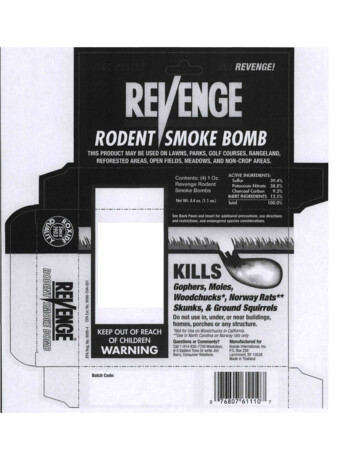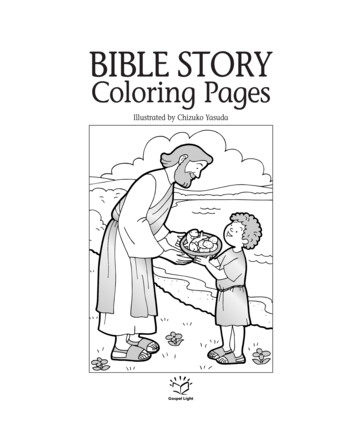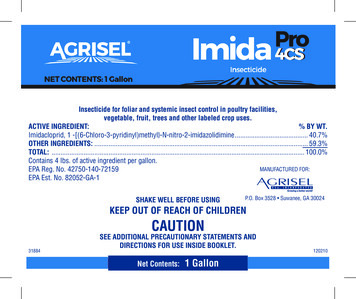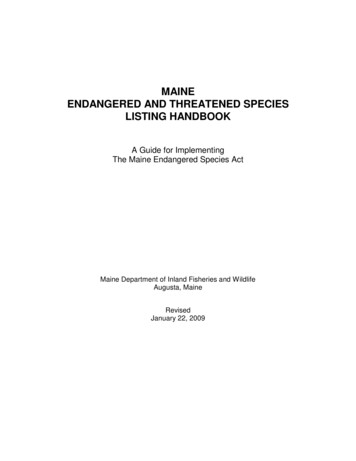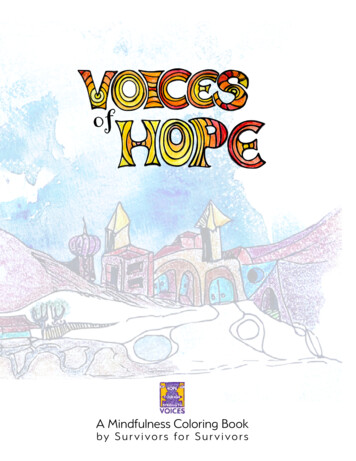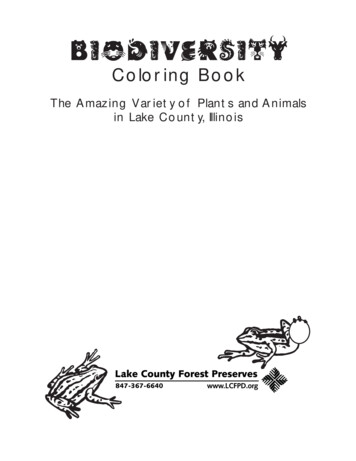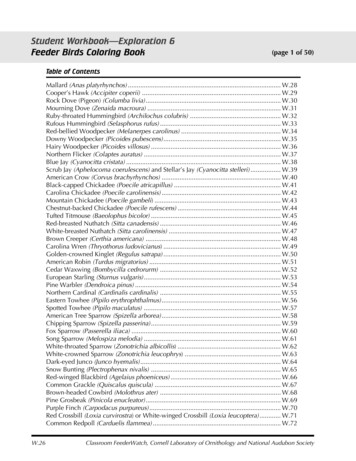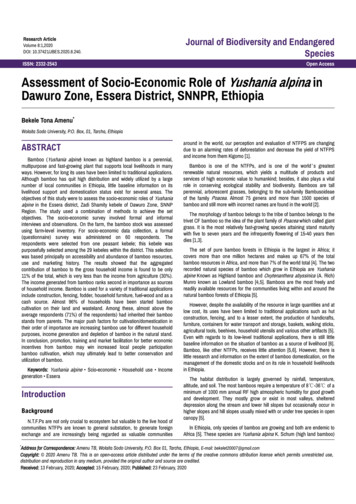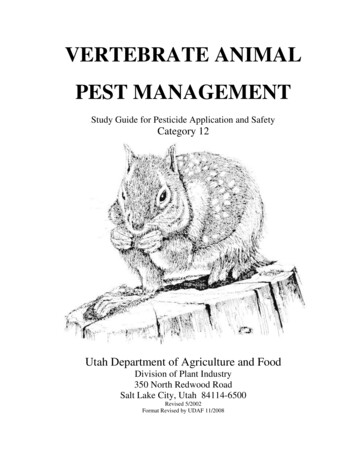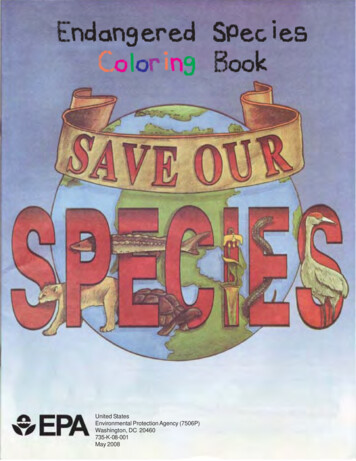
Transcription
EndangeredColoringUnited StatesEnvironmental Protection Agency (7506P)Washington, DC 20460735-K-08-001May 2008SpeciesBook
Hi, Reader!Readeader!This coloring book is published by the U.S. EnvironmentalProtection Agency’s (EPA’s) Office of Pesticide Programs.Did you know that when people use pesticides to kill insectsand other pests, they can also endanger the lives of plants andanimals? That’s why EPA has a program to protect threatenedand endangered species from contact with pesticides thatmight be harmful.If EPA determines that a pesticide may put at risk anendangered or threatened species, EPA will tell you on the labelof the pesticide container how to find out what you need to doto protect that species. EPA will have a bulletin that explainshow to use the product in a way that will not harm the species.The plants and animals shown in this coloring book are notalways threatened by pesticides; however, they do representmany different species our program is protecting.Endangered Species Protection Program
What Are Endangeredand ThreatenedSpecies?A century ago, a bird called thepassenger pigeon lived in NorthAmerica. There were so manypassenger pigeons that people oftensaw thousands, even millions, of birdsflying overhead. Today, there is nota single one left. What happened?mammoths, and saber-toothed tigers allbecame extinct long ago. Morerecently, the dodo bird and the sea minkalso have disappeared. Extinction hasbeen going on since life began on earthbut today, extinction is happening fasterthan everbefore.Thereare morethan 1,000endangeredorthreatenedspecies in the United States today. Canyou count to 1,000? EndangeredThe passenger pigeon becamespecies are those plants and animalsextinct. All passenger pigeonsdisappeared from the earth entirely. that are so rare, they are in danger ofThe passenger pigeon became extinct becoming extinct. Threatened speciesare plants and animals whose numbersfor two reasons. First, the forestswhere it lived were cut down to make are very low or becoming low quickly.Threatened species are not endangeredway for farms and cities. Second,many pigeons were shot for sport and yet, but are likely to becomeendangered in the future.because they were good to eat. Atthat time, there were no hunting lawsHow Do Plants and Animals Becometo protect endangered species likethere are now.Extinct?The passenger pigeon is one ofthe many plants and animals that oncelived on our planet and have becomeextinct. For example, dinosaurs,Species disappear because ofchanges to the earth that are causedeither by nature or by the actions ofpeople. Sometimes a naturalevent, like a volcano erupting,can kill an entire species.Other times, extinction willhappen slowly as naturechanges our world. Forexample, after the Ice Age,when the great glaciersmelted and the earth becamewarmer, many species diedbecause they could not live in1
a warmer climate. Newspecies that couldsurvive a warmerenvironment took theirplaces.People can alsocause the extinction ofplants and animals. Themain reason that manyspecies are endangered or threatenedtoday is because people have changedthe species’ homes or habitats. Ahabitat includes not only the otherplants and animals in an area, but all ofthe things needed for the species’ tolive — food, water, and shelter. TheUnited States has many habitats, fromocean beaches to mountain tops. Everyspecies requires a certain habitat inorder to live. A cactus, for example,needs the sunny, dry desert to grow.A polar bear,on the otherhand, wouldnot live in adesert,because itcould not findenough foodand water.The bald eagle is one bird that washarmed by pesticides. In the past, apesticide called DDT was used by manyfarmers. Rains washed the pesticideinto lakes and streams, where itpoisoned fish. After eating thepoisoned fish, the eagles would layeggs with very thin shells. These eggswere usually crushed before theycould hatch. Today, people are notallowed to use DDT.This coloring book will show you21 endangered and threatened plantsand animals found in the United States.As you color these pages, you willjourney to oceans, swamps, deserts,and islands and bring to life a varietyof plants and animals. If we all worktogether, we can continue to share theearth with these fascinating andimportant species and enjoy them inthe wild — not only in the pages ofPollution books.can alsoaffectwildlife andcontribute toextinction.The Nashville crayfish is endangeredmainly because the creek where it liveshas been polluted. Pesticides andother chemicals can harm plants andanimals if they are not used correctly.2
The fish gets its name from itsshort, pointy nose. The shortnosesturgeon is shaped like a torpedo.This helps it swim very fast. Thefish lives in rivers. In the winterand spring, it swims upstream to layeggs. The trip can be over 100miles long! Then, in the summer andfall, the fish swims to its secondhome in the ocean.In what states is this species found?3
Do you see the squiggly line on theriver bottom? It wasn’t made by asnake or a worm. It was made by adwarf wedge mussel when it draggeditself along the river bottom. Theseanimals look like small clams. Likesmall clams, they have hard shellsand soft bodies. Female mussels cancarry thousands of eggs inside theirvery small shells!In what states is this species found?4
The Nashville crayfish looks like avery small lobster. Like a lobster,the crayfish has claws that can pinch.Ouch! As a young crayfish grows, itgets too big for its shell. When thishappens, it grows a bigger shell.Then it casts off the old, smallershell. This is similar to a snakeshedding its skin when it grows.In what state is this species found?5
TAP TAP TAP! High up in the trunkof a pine tree, the red-cockadedwoodpecker digs a hole with itssharp beak. Sap flows from thetree and collects around the hole.The sap is sticky like glue. Thiskeeps the woodpecker safe frompredators, such as snakes. We needto protect the pine trees so the redcockaded woodpecker will have ahome.In what states is this species found?6
When full grown, the easternindigo snake is longer than mostpeople are tall! Indigo is the blueblack color of the snake’s skin.This snake eats birds, frogs, andeven other snakes. Snakes smellwith their tongues. Stick out yourtongue like a snake. What dohumans smell with?In what states is this species found?7
West Indian ManateeThis gentle animal lives in the coastalwaters of Georgia, Florida, Texas, andPuerto Rico. It is about 10 feet longand can weigh up to 2,000 pounds — asmuch as a car! Manatees areherbivores (meaning they eat onlyplants). After eating they may swimto the bottom of the water and rest.Manatees can hold their breath for upto 12 minutes at a time!In what states is this species found?8
This little lizard with bulging eyes isquite an acrobat. It races easilyacross cliffs and can even walkupside down! Full-grown Monitogeckos are about as big as yourthumb — only 1-1/2 inches long.In what state is this species found?9
The Florida panther has a cowlickof fur in the middle of its backthat sticks out. Like housecats,the Florida panther keeps clean bylicking its fur. These graceful catsmake a lot of different noises tocommunicate with one another.They chirp, peep, growl, and hiss.Panther kittens make a sound like awhistle to tell their their motherwhere they are.In what state is this species found?10
This plant eats insects! Do youlike to eat insects? When aninsect lands on one of theplant’s leaves, it gets stuck in agooey liquid. Then the insectslides down the leaf and intothe plant’s empty stem. Theinsect is digested just like wedigest food in our stomachs.In what states is this species found?11
These birds are about 4 feet tallwhen standing straight up on theirfeet. Sometimes, a group of craneswill dance in a great circle. Thecranes bow to their partners andleap into the air. This tall, grayishbird lives in savannah habitats and isvery rare.In what state is this species found?12
This bat has big ears and orangered fur. During the day, it sleepshanging upside down inside caves.At night, the bat hunts for mothsand other insects. On summerevenings, you might see bats flyingback to their caves. Hungrybabies are waiting to be fed!In what states is this species found?13
These little fish have leopard spotsand leopard speed! They zip throughrivers in a wink of an eye, dartingafter the insects they eat. Leoparddarters grow to only 3 inches longand live for 1 to 3 years.In what states is this species found?14
The Wyoming toad has green skinwith dark blotches. This coloringhelps it blend into the grass to hidefrom animals that might want to eatit. These toads have lived inWyoming a long time — since thegreat glaciers of the Ice Agedisappeared more than 12,000 yearsago!In what state is this species found?15
This tiny cactus is only 6 inchestall. and grows in the desert ofsouthern Texas. The plant’s pinkand purple flowers with redcenters are very pretty but watchout because this plant, like mostcacti, has spines as sharp as pins!In what state is this species found?16
Oo-loo-woo, sings the male prairiechicken to his mate. Prairiechickens sing and dance everyspring in the grasslands of Texas.Their dancing area is called the“booming ground” because of theloud songs of the males.In what state is this species found?17
This tortoise lives in the desertsof Arizona, southern Utah,Nevada, and California. Actually,it mostly lives under the desert!In the summer, the tortoise digstunnels underground to hide fromthe sun. Then all winter it sleeps,or “hibernates,” in deep holes.In what states is this species found?18
Some insects are endangered, too.The valley elderberry longhornbeetle lives only in California.Female beetles lay their eggs incracks and crevices in tree bark.From the time egg is laid, it takes 2years for an adult beetle, with itsbright green wings trimmed withorange, to appear!In what state is this species found?19
The mission blue butterfly flies andflutters, looking for just the rightflower in which to lay its eggs. In afew weeks, these eggs hatch intocaterpillars. Sometimes, thesecaterpillars are guarded by ants thatprotect them from enemies like fliesand other insects. The caterpillars“pay” the ants back by giving off asweet liquid that the ant likes to eat.In what state is this species found?20
The Mauna Kea silversword isfound only in the State of Hawaiion the island of Maui. The prettypink flowers of this plant can riseover 7 feet high! At the bottomof the plant is a ball of pointed,silvery leaves that look likeswords. The leaves are sharp likeswords, too.In what state is this species found?21
The bald eagle is our national symboland represents strength, courage, andfreedom. Its eyesight is so good thatit can spot a fish from more than amile away! It is so fast that it canswoop down through the air at 100miles an hour to catch this tasty mealwith its strong claws. Until recently,it was endangered. The population ofeagles had gone down rapidly with theuse of DDT. DDT was banned andnow the eagle population is rebuilding.In what states is this species found?22
You’d look pretty short standingnext to this 8-foot tall bear! Thegrizzly bear is one of the biggestanimals in North America. Adultgrizzly bears are shy and usuallylive alone. Young cubs stay withtheir mother for several yearswhile she teaches them to hunt,fish, and find berries and nuts.In what states is this species found?23
Index of Species’ Common Name,Scientific Name, and StatusPAGE345678910111213141516COMMON NAMEShortnose sturgeonDwarf wedge musselNashville crayfishRed-cockaded woodpeckerEastern indigo snakeFlorida manateeMonito geckoFlorida pantherGreen pitcher plantMississippi sandhill craneOzark big-eared batLeopard darterWyoming toadBlack lace cactus172021Attwater’s greater prairiechickenDesert tortoiseValley elderberry longhornbeetleMission blue butterflyMauna Kea silversword22Bald eagleIcaricia icarioides missionensisAgyroxiphium sandwicense spp.sandwicenseHaliaeetus leucocephalus23Grizzly bearUrsus arctos ( U.a. horribilis)1819SCIENTIFIC NAMEAcipenser brevirostrumAlasmidonta heterodonOrconectes shoupiPicoides borealisDrymarchon corais couperiTrichechus manatusSphaerodactylus micropithecusFelis concolor coryiSarracenia oreophilaGrus canadensis pullaPlecotus townsendii ingensPercina pantherinaBufo hemiophrys baxteriEchinocereus reichenbachii var.albertiiTympanuchus cupido geredEndangeredGopherus agassiziiThreatenedDesmocerus californicus dimorphus ThreatenedEndangeredEndangeredNo longerEndangered(As of June2007)ThreatenedTo learn more about how EPA, the Fish and Wildlife Service (FWS), and the NationalOceanic and Atmospheric Administration (NOAA) Fisheries Service protect endangeredspecies, please visit the following Web sites:EPA - www.epa.gov/esppFWS - http://www.fws.gov/endangered/wildlife.htmlNOAA Fisheries Service - http://www.nmfs.noaa.gov/pr/species/24
This coloring book will show you 21 endangered and threatened plants and animals found in the United States. As you color these pages, you will journey to oceans, swamps, deserts, and islands and bring to life a variety of plants and animals. If we all work together, we can continue to share the earth with these fascinating and
